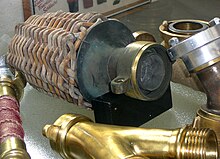Suction strainer
The suction head or suction head is a fitting for extracting water, for example in the fire brigade, and forms the receiving part of the suction line when water is extracted from open bodies of water .
It fulfills two tasks here: on the one hand, it prevents impurities from entering the pump's delivery flow, and on the other hand, it prevents the liquid column in the suction line from tearing off if the pumping process is interrupted. It thus ensures that the suction line is always filled with water. Furthermore, the suction strainer enables the suction line to be filled with water if the ventilation device fails.
construction

It consists of a housing with a sieve and a fixed coupling , as well as a non- return device with a lifting device. Its housing is cast from a rustproof light metal alloy, as the entire suction strainer must not weigh more than 6 kg. The sieve must be very robust and have openings with a maximum diameter of 6 mm, as larger particles can damage the pump. In addition, the strainer must have at least three feet and can have quick-release handles on the fixed coupling , which enable faster coupling to the suction line.
The non-return device, which is based on the effect of gravity , must close absolutely tightly up to an inclination of 30 ° relative to the horizontal . The lifting device is attached inside the sieve and provided with a ring. A snap hook can be attached to this so that the non-return device can be opened from the outside using a line pull. This is important in order to empty the suction line, as it is so heavy when filled that it can hardly be moved.
Special forms
Basement suction basket
The basement suction basket consists of a shoe with a sieve in the bottom, which stands on 1.5 cm high feet. In contrast to normal suction cups, which also draw in water / air from the side, the water can be pumped out up to 15 mm.
In practice, however, basement suction baskets are not very common because the suction line is very rigid and its use is therefore restricted. There are also alternatives such as water jet , turbo submersible and electric submersible pumps .
Suction guard
In use, the suction basket is additionally protected by a suction protection basket , this is particularly important on fine sandy and muddy ground, since the basket must not be immersed here.
It is put over the suction strainer at the end of the suction hose line. It is a coarse wire mesh that prevents contamination from leaves and pieces of wood and thus protects the centrifugal fire pump when pumping water.
A suction protection cage (also known as a wire protection cage) with a quick-release fastener (see picture) can remain on the suction cage as it is strapped onto the holder of the protection grille.
This means that no valve line can be pinched. In the past, the suction protection cages were often woven from willow wood , which is why they are sometimes referred to as wicker protection cages .
Notes on usage

If the suction line is placed in clean water, the opening of the suction head should point against the direction of flow in order to be able to use the flow pressure during the pumping process. In the case of heavily polluted water, however, it should point in the direction of flow so that dirt particles are driven past the basket by the flow pressure. If a suction line is used, it must always be ensured that the suction strainer is immersed at least 30 cm in order to be able to reliably prevent the entry of air even with larger delivery rates; In addition, it should always be secured by a tether and a valve rope attached to the lifting device of the non-return device. Since the pressure of the water column in the suction line is very high at high delivery heights, it is advisable to pull the valve cord while the pump is running and only then switch off the pump.
standardization
Suction cups are standardized according to DIN 14 362 in sizes A, B and C, but size A is the most common.
literature
- Lutz Rieck: Die Rote Hefte, booklet 06 - fire extinguishing fittings . Kohlhammer, Stuttgart 2000, ISBN 978-3-17-015171-0 , pp. 40-43 .
- Diverse: Hamilton - Handbook for the fire brigade . Boorberg Verlag, 21st edition 2012. ISBN 978-3-415-04560-6


